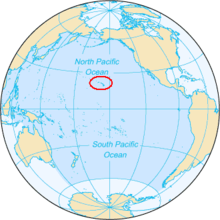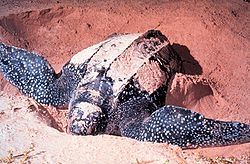Category Archives: Weird
Thieves Sneak Off With Catch From Aquarium in Waikiki
Thieves made off with 15 moi (a type of featherfin) from a display tank situated at the Waikiki Aquarium this past weekend.
They forced their way into the aquarium after it had shut its doors for the day, and made off with 15 of the 21 fish in an outdoor tank, sometime between Friday evening and Saturday morning, officials at the aquarium stated.
They made their way over a chain-link fence, cut out an opening in the netting of the tank, and then proceeded to abduct the fish using their own net, officials at the Waikiki Aquarium reported.
“It looks like they threw the moi out, they lay on the ground there and they put them in the bag,” Director of the Waikiki Aquarium, Andrew Rossiter, explained. “There were scales and blood there. There were two dead moi left there in the morning that they missed.”
Workers at the aquarium found the two deceased moi left unceremoniously on the ground in front of the tank.
The estimated value of the stolen fish is around $1,500, though who knows what someone will pay for them on the black market.
Even though the fish were stolen, Rossiter feels the need to implore that these particular fish are not fit for human consumption, as they were prepped for breeding and thus contain some hormones and chemicals which make a fairly unappetizing cocktail.
“I would guess that they’ve been treated probably with hormones and probably with medication because they’re adult fish and they were for breeding,” he said.
One wonders why not take all the fish? And also.. What the heck are they going to do with them?
Save Water, Or Risk Killing Goldie
This is certainly an interesting way to get people interested in conserving our planets’ water supply.
It appears that finally someone has come up with a way for us to be more conscientious of how much water we use.. Use less, or kill of your friend.. A rather ingenious, if a little sadistic, designer by the name of Yan Lu has come up with a sink that basically threatens to kill off an innocent goldfish if you use too much water when washing your hands.
It works much on the same principal as a toilet. As you wash your hands the water slowly empties out of a bowl which houses your friendly neighborhood goldfish, and when you are finished, gradually places more water back into the bowl.
The invention has been dubbed the “Poor Little Fishbowl Sink” and has been making quite a big splash in articles around the globe. You don’t need to worry about washing your hands with fishy water either, the water from the bowl empties into a different place, and doesn’t come out of the tap.
Of course, Yan Lu is not a sadist, so the bowl will never completely empty, though you can bet the poor goldfish is getting quite a workout on the old heart every time his home starts to disappear!
Lu is quoted as saying on his website: “As consumption is incalculable, saving is often neglected through daily consumption. Rather than forcing people to consume less, thus depressing the using experience, Poor Little Fish basin offers an emotional way to persuade consumers to think about saving water, by making consumption tangible.”
Way to go and help save the planet Lu! A few stressed out goldfish is worth it, if we can help ourselves to stop being so selfish by wasting water.
Shocking Suprise – Human foot found in shark (Graphic Pictures)
Just as a deep sea fisherman was about to cut away a hook from a wide open mouth of a shark to let it go back on its merry way to the sea, the most surprising thing sprung forth.. A human foot.
“Everything was intact from the knee down,” commented Humphrey Simmons, a Bahamian investment banker, “it was mangled, but there was still flesh on the bone.”
What a morbid way to end such a beautiful day of fishing for Mr. Simmons and his two cohorts, who spent the majority of their morning trying to get away from the sea beasts.
When they finally managed to reel in the curiously heavy and bulging Tiger shark, at the Defence Force’s Coral Harbor base and they got around to sticking a knife in him, to see what was what, a headless body came tumbling out of the freshly opened cavity. The leg which the shark so unceremoniously coughed up appeared to belong to the man, as he too was missing a foot. Upon closer examination of the sharks insides, they indeed found the rest of the man; severed right leg, two severed arms and a torso in two sections.
As Mr Simmons’ ten year old daughter calmly pointed out, the shark had the feast all to himself. There were no signs of a struggle, or fighting from other sharks. The theory going around now is that the unlucky man drowned, and then was scarfed up by the shark.
- The caught shark
- Cut open
- The foot
Death From Jellyfish-Sting, First in Europe
Authorities have said that a woman had a deadly reaction and died after being stung by a jellyfish on an Italian beach.
Maria Farcus, 69, is thought to be the first such case of a person dying of a jellyfish-sting in Europe.
Furcas came up onto the beach and collapsed having suffered what appeared to be anaphylactic shock after being stung by the Portuguese Man-of-war jellyfish. Paramedics rushed onto the scene, but were unable to save her, reported the Daily Mail.
“The lady came out of the water dragging her leg and screaming she had been stung by a jellyfish. There was a very vivid red mark on her right leg. Then she collapsed to the ground and a lifeguard and other people on the beach rushed to help her. … She died on the sand in front of dozens of people” A witness on the scene reported.
Experts have said that they believe that Furcas’s case is the first fatal case in the Mediterranean, despite the fact that thousands are stung each year on the beaches by jellyfish.
Furcas’s death happened just days after more than 700 jellyfish stings were reported along the Costa Blanca in Spain.
“This type of jellyfish has always been present in the Mediterranean but now they are increasing in numbers due to global warming and they can grow tentacles up to 60 feet long,” explained a marine biology lecturer at the University of Lecce, Ferdinando Boero.
Two-Headed Turtle in Phuket Needs Name
Well, this is certainly interesting news. It appears that a two-headed turtle (Picture gallery) has gripped the attention of Phuket, and may turn into a full blow two-headed turtle mania if the media coverage is any indication.
The Royal Thai Navy has created a contest to help come up with a suitable name for the 18-day old turtle, which really created a stir when it was put on display in the turtle sanctuary at the Navy base in Tablamu, just to the north of Phuket.
Chatjen Choipean, a warrant officer who is in charge of many functions at the Navy hatchery beach at Hu Young Island in the Similans has commented that the two-headed turtle was the last in a batch of 26 turtles to hatch from the laying of 96 eggs. Turtles often lay there eggs on the beach between November and February.
This Olive Ridley turtle, officials are keeping their fingers crossed, may just do the same thing for Phuket and other turtles that a young panda has done for the Chinang Mai Zoo.
Last year, Warrant officer Chatjen explained, there were 80 separate nests made and eggs laid on the island. However, so far this year, there have only been 30.
”The young two-headed turtle is very strong and doing well,” he commented. This is the first time that a two-headed turtle has made an appearance in the Navy region, and many hope that it is a sign of good luck for the breeding attempts in the future, especially on the mainland and Phuket.
Visitors are encouraged to view the turtle at Tablamu, where they can also take advantage of one of the best golf courses in the area, and engage in one of many of the activities available in the surrounding Phang Nga countryside.
It is not known whether the two-headed turtle is male or female, and it could take up to 5 years to discover which it is, however, this will have no bearing on the decision of a name.
More Than 700 Tourists Attacked by Jellyfish in Spain!
It has been reported that in the warm, sunny, and usually tranquil beaches of Spain that at least 700 tourists have been stung by small, transparent jellyfish this past week, leading the local officials to rapidly post up warning signs.
The wiggly little invaders have caused “a swimmer’s nightmare,” reports The Associated Press.
The majority of the attacks seem to be occurring the most often near the city of Elche in Eastern Spain, in an area known as Costa Blanca, a rather popular tourist destination for its remarkable white sand beaches.
This past Tuesday alone, 380 people felt the sting from these tiny creatures, comments Juan Carlos Castellanos of the Elche city department for tourism and tourism development.
“In the five or six years I have been in this job, I have never seen anything like this,” Castellanos calmly explains to the AP.
Besides putting up signs warning people of the dangers, officials from Elche are keeping a close lokout for the jellyfish from boats so they can warn the crowds on the beaches when a swarm is approaching.
Meanwhile, just off of the northern coast, in Cantabria and the Basque region, more menacing, and likely more painful, jellyfish-like Portuguese man-of-wars have been inciting their own wave of fear. More than 300 people have had the misfortune of being stun by on those bad boys during the past three weeks, AP comments.
No one knows for sure why the jellyfish are coming up in such immense numbers, but researchers are blaming it on global warming and overfishing practices in the region.
Rare “Princess” Turtle Makes Way Home After 32 Years
Well, they say turtles are slow, but this particular beauty made a surprise comeback to a Malaysian beach after an astonishing 32 years. A report issued Friday hailed this return as a “miracle” by conservationists and rekindling hope that the endangered species is not quite gone yet.
The leatherbacks, the biggest of all the sea turtle species, were at one time the stars of the show at Rantau Abang beach in the northern state of Terengganu. However, overfishing, poaching, and pollution have caused the population of these turtles to take a nose dive over the years, to the point of being critically endangered.
This turtle, aptly named “Puteri Rantau Abang” or Rantau Abang Princess, and identified by some special markings, had returned last month to finally end the long period of time that turtle sightings were rare, which began in Terengganu in the 1980’s.
“It is a miracle that leatherback turtles are making a comeback to this area,” commented, Ahamad Sabki Mahmood, the Malaysian Fisheries Department director-general.
He went on to explain that the return of this turtle proves that Rantau Abang is once again being made a nesting ground for turtles, he is hoping that the next possible nesting period between the 15th of August and 20th of August that more turtles will make an appearance.
This just goes to show you that old habits die hard, and that mother nature triumphs over all. Hopefully the future turtles which land at the beach will receive as warm a welcome.
15 Year Old Claims Cops Forced Him to Leave Shark On the Beach to Die
Left on the beach for dead. This is the extremely sad thing which happened to an 8 foot sand tiger shark at Carolina Beach the night before yesterday. WWAY found the shark dead and decaying in a maintenance yard today.
A 15 year old resident and his cohorts are claiming that the police told them to take the shark out of the water and leave it on the beach to die. The youngsters admonish that they wanted to save the poor thing, by pushing it back out into the water, but they did as they were told.
The sand tiger shark is a protected species, and as such it should not have been left to die out there on the beach. The shark was discovered at 11:30 PM Tuesday on Carolina Beach in front of the boardwalk. The local authorities called in a tow truck to remove the beast before any tourists arrived in the morning. Spectators could only watch in awe, as the shark swung from the back of the truck, taking its last breaths.
The shark was just unceremoniously dumped off in a maintenance yard, where later, someone decided to take its teeth as a souvenir. Evan Pye says that the local constabularies just sat back in their cruisers and watched the horrid scene unfold last night.
“They were just like, ‘Sons bring it up here.’ We’re like ‘Why? Why bring it up here?’ because we were trying to make it live. ‘No, you got to bring it up here. You got to bring it up here.’ We’re like ‘We’re not going to bring it up there,’ and they’re like, ‘Bring it up right now,’ and started yelling at us and stuff like that and telling us that they’re going to arrest us and stuff like that,” Pye explained.
The chief of police has made an apology, but it is not yet clear if the officers in question will be reprimanded for this horrid decision they made.
U.S. Sportfishing Boat Attacked by Communists Off Costa Rica
A United States based world fisheries conservation association is gunning for punishment to be dished out, after a sportfishing boat was attacked by a commercial Venezuelan tuna purse seining boat and a helicopter off of Costa Rica’s coast.
This incident was reported, and is well documented, on The Billfish Foundation’s website: http://www.billfish.org.
The past August 1st, at just about 3PM, a United States sportfishing boat, the Silver-Rod-O, owned by Gary Carter, a TBF member, of Duluth, GA., was assaulted by the other craft, Venezuelan flagged tuna purse seiner La Rosa Mistica (The Mystic Rose), while minding its own business some 15 miles off the shores of Garza, Costa Rica.
According to Gary, the Silver-Rod-O was minding its own business, trolling around a school of spinner dolphin for yellow fin tuna and billfish, when a helicopter off of the La Rosa Mistica, began to circle overhead.
“We were celebrating one of our guest’s first-ever sailfish release, when the seiner veered from its course and headed directly toward our boat. The helicopter then began making passes over the anglers and as the seiner came closer and began setting its net, the helicopter started dropping incendiary devises around the Silver-Rod-O and the school of spinners.”
“Several explosives landed within 50 meters of the boat. The purse seiner continued to power straight toward our boat,” Carter said, “It was threatening to either encircle us in their net or to plow us into the sea unless we abandoned the school of dolphin. Rather than endanger our guests, we retreated and watched and listened as the La Rosa Mistica closed the net and its crew obnoxiously celebrated its victory.”
Just goes to show you, be careful where you fish! Hopefully, the Costa Rican authorities will look into the matter, and justice will be served.
Vintage Booze Found in Shipwreck yet to be Named
“For this wine, time has stood still,” commented chief cellarman of Veuve-Clicquot, after swirling the two hundred year old wine around in his mouth. This spectacular find was found off of Sweden.
A bottle of champagne which is purportedly two hundred some odd years old was found in a shipwreck at the bottom of the Baltic, it tastes exceptional, however, it is not found the house of Veuve-Clicquot as was previously assumed.
Last month, Swedish divers making their rounds off of Finland, came across 30 bottles of perfectly preserved champagne at a depth of 180 feet. These bottles of champagne may just have been part of a consignment sent by King Louis XVI (of France) to the Russian Imperial Court.
Due to the fact that the corks still had a hint of an anchor logo, experts originally thought that the champagne might have come from the historic Veuve-Clicquot estate, which till this day, is still one of the best brands in terms of champagne.
However, after being put to the test, the firm has said that while it is perfectly preserved, the brew came from the now non-existent Juglar house.
“For this wine, time has stood still,” commented chief cellarman, Dominique Demarville, of Veuve-Clicquot, one of a small number of people who has had the privilege to sample a few millimeters of the discovery.
“It seems to me that it must taste the same as it did when it was made.”










